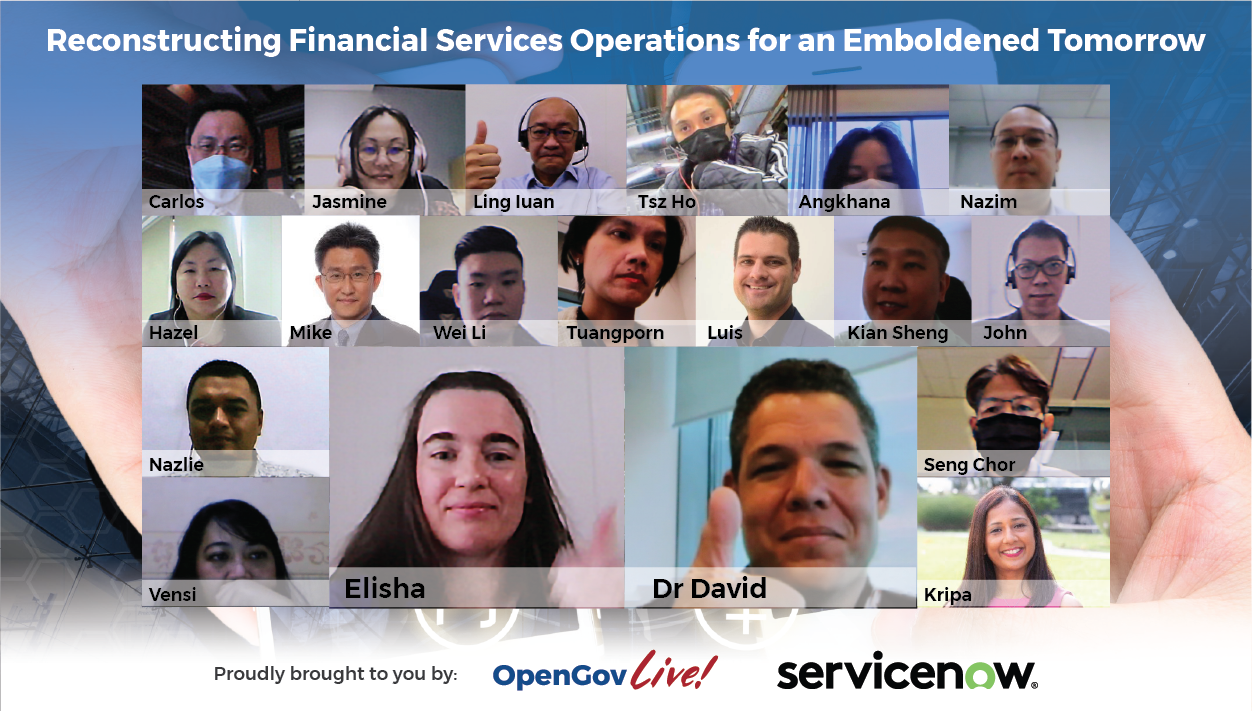
A forced surge of remote employment, online purchasing and virtual entertainment during the pandemic resulted in a rapid global transition into the digital economy. The capability and quickness with which organisations put all or a portion of their services online were essential to the success of many enterprises.
Similarly, the financial services sector is going through a significant transition as FinTech has changed the way things are done by giving clients new ways to get the services they need. The shift in thinking has ignited the desire to transform the way the industry does business using digital technology. Moreover, tech-enabled change has raised consumers’ expectations of service speed and ease of transaction by demonstrating that access does not always have to be a point of contention.
Institutions have recently been forced to quickly shift gears on multiple levels. This includes developing new ways to communicate with clients, allowing personnel to operate remotely in a secure manner, and providing services to customers as soon as possible.
As a result of this shift, it became clear that digital fragmentation and silos in the middle and back offices are impeding growth. Gaining and maintaining the trust of customers and government regulators, on the other hand, necessitates dependability, promptness, and adaptability.
To be effective, the digital transformation of industry must extend beyond the user interface and into the core of operations. Financial institutions must address their disconnected approach and seek holistic solutions to organisational problems to effect true transformation.
The benefits of an efficient and cohesive bank-wide operational platform to engage customer experiences were the focus of the OpenGovLive! Virtual Breakfast Insight on 17 August 2022 with the top financial services industry leaders from Singapore, Indonesia, Malaysia, the Philippines, and Thailand.
Reimagining Customer Experiences Using FinTech

Kicking off the session, Mohit Sagar, CEO & Editor-in-Chief, acknowledges that the financial services sector is going through a significant shift. He explained that FinTech has changed the way things are done by offering clients new ways to get the services they need.
These tech-enabled changes have changed consumers’ expectations of service speed and ease of business by demonstrating that access does not always have to be a point of dispute. It ignited the desire to transform the way the industry does business using digital technology.
“Financial institutions must address their fragmented strategy and look for solutions that address organisational problems holistically if they want to see real change and success,” Mohit strongly believes.
Recent times have required institutions to change course swiftly in several areas, including finding new ways to connect with customers, enabling employees to work remotely in a secure manner and providing services that customers need right away.
The change made it clear how digital silos in the middle and back office are preventing advancement. Moreover, the middle and back offices, where client information is still characterised, suffer greatly from highly fragmented systems and manual processes. Manual processes in these areas severely impede functioning, making it difficult and time-consuming to carry out work across several functional areas.
Reliability, speed and agility are necessary for establishing confidence with customers and regulators. The industry’s digital transformation must penetrate deeper than the sleek user interface to the core of operations if it is to succeed.
Mohit contends that simultaneous agreement on the same information by all parties must be possible during financial service operations. It should give organisations all the information they require to boost resilience and develop more client-focused operations. Additionally, it needs to help executives comprehend the operational data they require to make wiser choices.
Operations of financial services must allow all parties to concur simultaneously on the same information. It should offer businesses all the information they need to enhance resilience and establish more client-focused operations. In addition, it should provide executives with a better grasp of the operational data they need to make better decisions.
Reshaping the Future of the Financial Services

“Every financial institution needs to update their technology to provide a better customer experience,” says Elisha Harrington, Senior Director, Chief Innovation Office, ServiceNow.
Governments may need to consider drafting new laws and legislation to oversee the FinTech industry with its rapid expansion. With new business models based on the use of big data, FinTech can disrupt the financial industry including banks.
Clean sources of energy can be brought to fruition through the right combination of planning consent, strategic priorities, and availability of capital. Such initiatives could be given preferential consideration to make them more appealing.
Typical projects that fall under green financing are pollution prevention and control; biodiversity conservation; renewable energy and energy efficiency; among others.
Companies can develop the business value of their social impact through enhanced data measurement and analysis methods. By doing so, businesses are better able to evaluate risks, allocate resources, project growth for these activities and finally make strategic decisions.
Elisha agrees that financial technology uses software and algorithms on computers and smartphones to help consumers and business owners better manage their financial operations. However, new risks are constantly emerging because of the rapid pace of innovation and change. Although fast transacting cross-border transactions are a powerful tool of FinTech, financial companies will also need to adapt more robust risk measurements to keep up with such speed and pace.
An industry that is at the forefront of technological advancement attracts those looking to engage in fraudulent schemes or artifices because they see chances to take advantage of gaps in data protection. When dealing with risk and compliance issues, FinTech companies must start by recognising the value of risk management.
Most organisations are often not fully prepared to avoid fraud because of the ongoing changes in technology and the rise in the frequency and volume of digital transactions. Thus, the continuing advancement of machine learning fraud protection methods utilising AI is one way the FinTech sector has complemented conventional fraud prevention policies and procedures.
In Conversation With: Seamless Connections and Efficient Productivity for Secure Digital Workflows

In the middle and back office, where client information is siloed, highly fragmented systems and manual procedures create massive inefficiencies.
Banks find it difficult to connect the dots internally and prepare bank-wide views of a customer relationship, let alone integrate data from external sources. As a result, risk and credit decisions are usually made at the product level rather than the customer level.
Dr David R. Hardoon, Chief Data and AI Officer, Union Bank of the Philippines, Chief Data and Innovation Officer, Aboitiz Group is of the opinion that financial services operations must ensure that everyone is on the same page and has access to the same information at the same time.
It is vital to provide institutions with the end-to-end visibility they need to improve resilience and build more customer-centric operations. his would give executives a clearer picture of the operational facts they need to make better decisions.
Manual processes are common in the middle and back office, which makes it hard and slow to get work done in different functional areas. One wrong or lost email can cause a backlog that lasts for days.
With secure digital workflows in place, the right person can be told to act at the right time. It makes complicated processes that span different teams easier to understand, so work can be done quickly and easily. It also cuts down on work redundancy, which is a common cause of dissatisfaction, fatigue and error that do not need to be made.
“When you begin your digital journey, you will encounter bumps along the way, but things will become clearer as you progress,” says Dr David.
He explained that by working with better tools and insights, employees can be more effective and make the customer experience better. Less time is spent on regular tasks and more time is spent on things that affect customers. Safe digital solutions, centrally locate, and feature automated document workflows – from digital reception or scan to compliant destruction – are not just for large corporations.
Security, compliance, and account management are significant considerations if more personnel will have access to corporate and consumer data while they are not in the office. As a result, management will need to have a clear “line of sight,” and audit trails will become even more crucial.
Furthermore, if a company wants to implement a digital strategy to boost operational effectiveness and business continuity, using the correct technologies is essential. Even though internal networking is not talked about as much, it has a lot of benefits for both the employee and the company. Internal networking helps people come up with great ideas that could help the company be successful. Part of this is also working together across departments and helping people grow in their jobs.
By having casual conversations with employees, the organisation can find out useful information and learn about new industry and business trends, come up with new project ideas, find out about upcoming product/service launches and determine what the company needs. All of this has the potential to create job openings and crystalise the company’s mission and vision.
David emphasised that good management communication is one of the most important factors in the success of an organisation. “Organisations with effective management communication plans are at a significant advantage over those who don’t recognise the value of communication at work.”
When teams are split up, it’s bad for business. This is because silos make it harder for people to talk to each other and put more space between team members. Because of this, there are more company mistakes and bad customer experiences, while team culture, camaraderie and collaboration deteriorate. Even teams with all-star players can become dysfunctional, ineffective and inefficient if employees do not work together to reach organisational goals.
Teams stay together when they can talk to each other well, which is why silos are so dangerous. Attribute failures in the workplace to a lack of teamwork or poor communication. Team connection is without a doubt essential for business success.
Elisha shared that teams that do not work together share little information. Because of this, they cut themselves off from the rest of the company’s business. People with a silo mentality also see team members from other departments as “outsiders.”
Because they do not fully understand how and why teams work together, they do not talk to or interact with them as much as they could. Leaders and employees who work in separate groups are bad for the company’s team culture.
Lastly, this stuck perspective makes it harder for the company to reach its goal. One of the worst things that can happen because of silos is that clients have bad experiences. Finally, it is up to the organisation to meet the needs of its clients.
Without communication and teamwork, it is ten times harder to give a great customer experience. Companies cannot afford to make the business mistake of letting silos exist because customers are the lifeblood of a business. The main signs of segregated teams are a lack of communication, angry customers, low productivity, a lack of accountability and a brand message that does not make sense.
Sharing information, getting rid of competitive attitudes between teams, putting employees from different teams in touch with each other, and training leaders who do not let silos form are all ways to build a more connected and communicative team culture.
When cooperation is not a top priority, it hurts companies in many ways. This could mean losing valuable employees or money because of a lack of communication, which leads to big mistakes in business.
Elisha believes that one of the best ways to solve this problem is for leaders to give collaboration and teamwork more weight when evaluating employees and deciding who will be the next generation of leaders.
This shows that there is a strong link between how well a company does and how well its teams work together. Make teamwork a measurable value when coming up with key performance indicators (KPIs) and other ways to measure performance.
Every business needs people who are excited about their work and give it their all. The key to tapping into this endless source of energy is to build stronger bonds among your staff and between management and workers. Using the right internal communication technologies can help offices work together better, speed up processes and make the company more productive.
Transparency, letting employees know they are being heard, keeping everyone up to date, being real, having open dialogue, making recognition a way of life and culture, and defining, sharing and living by a company’s mission, vision and values are some of the best ways to connect with your employees and make them feel truly committed to your business.
When employees are happy and feel like they belong with their coworkers, they are more engaged and driven. They will not only want to stay with the organisation, but they will also be more willing to teach others what they know.
There will always be some difference in how productive each employee is – Not always is that a bad thing. After all, a worker who takes a long time to do one great piece of work is just as valuable as someone who can do a lot of work quickly. Problem-solving in a warehouse will be done at a different speed and with different goals than problem-solving in an office.
Businesses can analyse corporate or team productivity as well as individual employee output rates. Working on a larger scale can help corporate executives ensure that their teams have the right mix of people.
The industry and the type of work performed by people will dictate how to set a productivity standard. As employees learn more about how the organisation works, the organisation may likely establish and alter productivity criteria.
Elisha added that holistic governance is also essential since it determines the organisational purpose and strategy, thereby expanding the company’s attention beyond shareholders to include other stakeholders. The company’s accountability procedures are designed to ensure that actions lead to the organisation’s long-term success and responsible behaviour.
Consequently, holistic governance can be defined as a system of action comprising strategic and monitoring activities that determines how a company prioritises its responsibilities to its shareholders and stakeholders and is determined at any given time by the interplay between institutional drivers and behavioural norms.
Closing Remarks
Elisha agrees that promoting sustainability and transparency in the financial sector is key to making companies and their international supply chains more sustainable. Because of this, governments and the public need to know that banks are open and answerable.
Scalability is a good thing about the cloud for financial firms, but it’s important to look at scalability alongside other important aspects of cloud services, like security, cost-effectiveness, and transparency. Financial innovation is the only way to withstand the huge changes and revolutions the financial industry has seen.
Therefore, financial services organisations should not be hesitant to go to the cloud; the investment in time and expense in establishing and operating IT infrastructure may be drastically reduced, and the benefits of on-demand scalability are especially essential in this area.
Agile adoption and innovations can be developed together through strategic alliances and partnerships with digital transformation firms and the top financial solution providers.
Mohit encourages partnership in cloud adoption as it can provide the expertise needed to market, design, integrate, customise, deploy, and support new applications on-premises, in the public cloud, or in hybrid cloud architectures.
Partnerships let providers add services like managed security, IoT solutions, and analytics to their list of services, which helps them stand out, says Mohit. Such organisations, in addition to being “complex adaptive systems,” are using people, tasks and technologies to accomplish specific goals and objectives.
“It is equally critical to consider the organisational structure and how it is managed. The structure depicts the division and allocation of labour among members such as managers and employees, as well as the coordination of actions to achieve the organisation’s stated goals and objectives,” Mohit concludes.
















